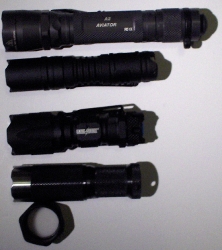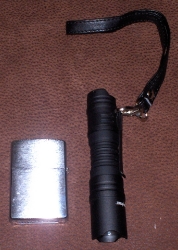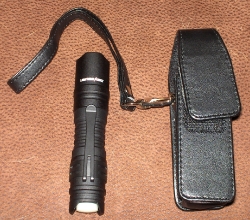 |
A Closer Look:
Back to the flashlight, this bad boy is made from CNC-machined aluminum, with a mil-spec HA-3 hard-anodized coating. This offers a very good strength/weight ratio, and the coating makes them remarkably resistant to scratches and corrosion… though strong bases (like that found in drain cleaner and alkaline batteries) will eat through the coating and eath away at the metal. Making our way back, there’s a series of aggressive grooves cut into the metal, making keeping your grip on the Lightning Strike, even when your hands are covered in oil, remarkably easy. Wrapped around the tailcap is a matte black, spring-steel clip that may not be thick enough to clip it all the way to thick pockets, or considering the target market, leather purses. Climbing all the way to the end, the tailcap is crowned with a glow-in-the-dark push button, and the unique ‘Tactical Touch’ switch. While the push button is a fairly common “reverse clicky” switch, it is the most tightly tuned example I’ve ever seen, requiring the least pressure to switch modes of any like it I’ve tried. Modes are changed by clicking or double-clicking the switch a quarter-press, moving from high, to low, to the blinding tactical strobe (looping back to high again). What makes this interesting is also the cut-outs on the switch, which are designed to protect the switching mechanism if dropped, and allow the smack to be laid down (remember, this is designed to be used as a fist-load). While ostensibly, they intended this cutout to accommodate women with over sized fingernails, I’ve found it to be a good idea in more than just that situation – it also allows the light to tailstand (it’s a bit wobbly, though), acting as an area-light with light reflected by the ceiling.
Speaking of batteries, this is somewhat unique in tactical lights, in that it uses AA batteries. Alkalines have some trouble supplying the currents demanded by powerful LEDs (when I first picked this up and turned it on, I thought it was broken – but it was just a dead battery), though rechargeable ni-mh cells tend to do much better under load (and eventually pay for themselves with the money you save). That said, Brite-Strike recommends against rechargeable batteries, as they have a bad habit of running themselves down even if you don’t use them. I tried Energizer lithium cells, and they were just as bright as the rechargeables, lighter, and they never leak.
The batteries are feeding a Luxeon Rebel emitter by Phillips LumiLEDs, who developed the first high-power white LED, the Luxeon Star. I’m not sure of the exact bin code (model number) of the emitter, but the light is (by LED standards) a warm, peachy white; not the usual harsh, cold blue-tinted light produced by LEDs. That is to say, this is a premium LED, which often perform better outdoors, where plants and trees gobble up the blue end of the spectrum. While the ‘Luxeon lottery’ means all such things may vary, this is a good sign.




[…] Brite-Strike Lightning Strike Tactical Flashlight Review @ Techwarelabs […]
[…] Brite-Strike Lightning Strike Tactical Flashlight Review @ Techwarelabs […]